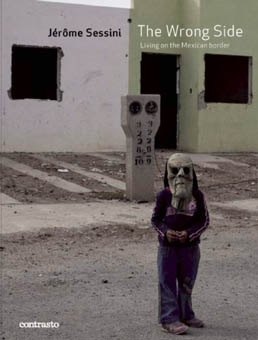LIVING ON THE MEXICAN BORDER
JEROME SESSINI
Editeur : CONTRASTO
Année de parution : 2013
La violence transpire à travers les images. Le photographe s’est rendu au cœur des villes les plus violentes du Mexique : Ciudad Juarez, Tijuana ou encore Culiacan. Une violence qui touche le lecteur, et à laquelle le photographe a été confronté lors de son reportage. Toutefois, assure-t-il, « avec l’appareil photo c’est plus facile. Il y a comme un filtre entre nous et le sujet. C’est une distance qui se fait naturellement. »Ces photographies introduisent le lecteur dans le quotidien de Mexicains directement touchés par ce conflit armé. Quand j’ai connu le Mexique il y a 15 ans, c’était un pays assez facile à photographier, les gens avaient une relation à l’image très différente de celle en Europe. Mais cela a changé en 2008 avec la crise, et la paranoïa s’est installée dans les villes du nord. Même les photos les plus simples étaient carrément devenues impossibles. » C’est seulement au bout d’un an de travail que le photographe a pu entrer chez les protagonistes de son reportage. Une intégration rendue notamment possible grâce aux différentes rencontres sur place, « d’anciens toxicos, ou des personnes qui avaient fait de la prison et qui connaissaient le milieu. »A travers les photos, le lecteur devient le témoin de la prostitution, la drogue, la pauvreté et la mort. Il assiste aux injections des toxicomanes. Au réveil d’une prostituée, seule dans une chambre d’hôtel. Ainsi qu’à des arrestations de la police. Enfin, des photos du désert qui sépare les Etats-Unis du Mexique et de la frontière font définitivement écho à la phrase du général Felipe Porfirio. Elles résonnent comme un rêve américain devenu aujourd’hui impossible. Les Mexicains de ces villes du nord seraient donc nés du mauvais côté ?Le livre regroupe 90 photographies en couleur. Même si les problèmes à la frontière ont commencé en 2001, le conflit s’est intensifié depuis 2008. Un ouvrage très riche, sur un conflit qui n’en finit pas. « J’ai senti que j’avais suffisamment de photos pour raconter quelque chose à travers un livre. Mais il faut se fixer des limites. Sinon je serais encore là-bas… »
"THE WRONG SIDE" :
Living on the Mexican Border Jérôme SESSINI "Poor Mexico, so far from God and so close to the United States," declared General Porfirio Diaz in the XIX century. This sentiment, which some still feel today, is explored by Jérôme Sessini in his latest book, "The Wrong Side."
Sessini, a member of Magnum Photo Agency, has been covering international conflicts for years. He very quickly became interested in Latin America, particularly in Mexico. In 2008, the president Felipe Caldéron launched a "war against drug trafficking," deploying thousands of troops and police to the most sensitive Mexican cities. Seeing Mexico’s situation, Jérôme Sessini felt he had to cover this crisis in an extensive manner. From 2008 to 2011, he returned to Mexico dozens of times, photographing the consequences drug cartel conflicts. He describes this conflict as "a nearly un-photographable war."
Violence transpires throughout these images. For this series, the photographer traveled to the hearts of the most violent villages in Mexico : Ciudad Juarez, Tijuana, and Culiacan. This same violence that affects the viewer also affected the photographer during his reporting. However, he assures us, "with the camera it’s much easier. There’s a filter in between me and the subject. It is a distance that occurs naturally."
These photographs introduce the viewer to the daily lives of Mexicans who are directly affected by armed conflict. "When I knew Mexico fifteen years ago," Sessini says, "it was a relatively easy country to photograph, as the people there had a relationship to images very different from that of Europeans. But this all changed in 2008 with the crisis, and a wave of paranoia swept over the northern cities. After this, even taking the most simple photographs became nearly impossible." It was only after a year of work that the photographer was able to enter the homes of his subjects. This intimate integration was made possible by people he met while reporting, "by former addicts and people who had spent time in jail who could act as middle-men with the cartels."
Looking at these photographs, the viewer becomes a witness of prostitution, drugs, poverty and death. He helps with drug injections. He wakes a prostitute, alone in her room. He assists during police arrests. Finally, the photos of the desert separating the US from Mexico definitively echo general Porfirio’s quote. Through these images, we see an American dream that has now become impossible. So we must ask ourselves, were the Mexicans who live in these northern cities simply born on the wrong side of the border?
This book includes ninety color photographs taken by Jérôme Sessini. Although the problems at the border began in 2001, the conflict has intensified since 2008, when Sessini began his series. The final result is a rich and just portrait of a never ending conflict. "I felt that I had enough images to tell a story in a book," Sessini says. "We have to set limits. Otherwise, I would still be there today…"

Lettre d’information
75004 Paris – France
+33 (0)1 42 74 26 36
ouverture du mercredi au samedi
de 13h30 à 18h30. Entrée libre
M° Rambuteau – Les Halles
Pour Que l’Esprit Vive
20 rue Lalande
75014 Paris – France
T. 33(0)1 81 80 03 66
www.pqev.org

